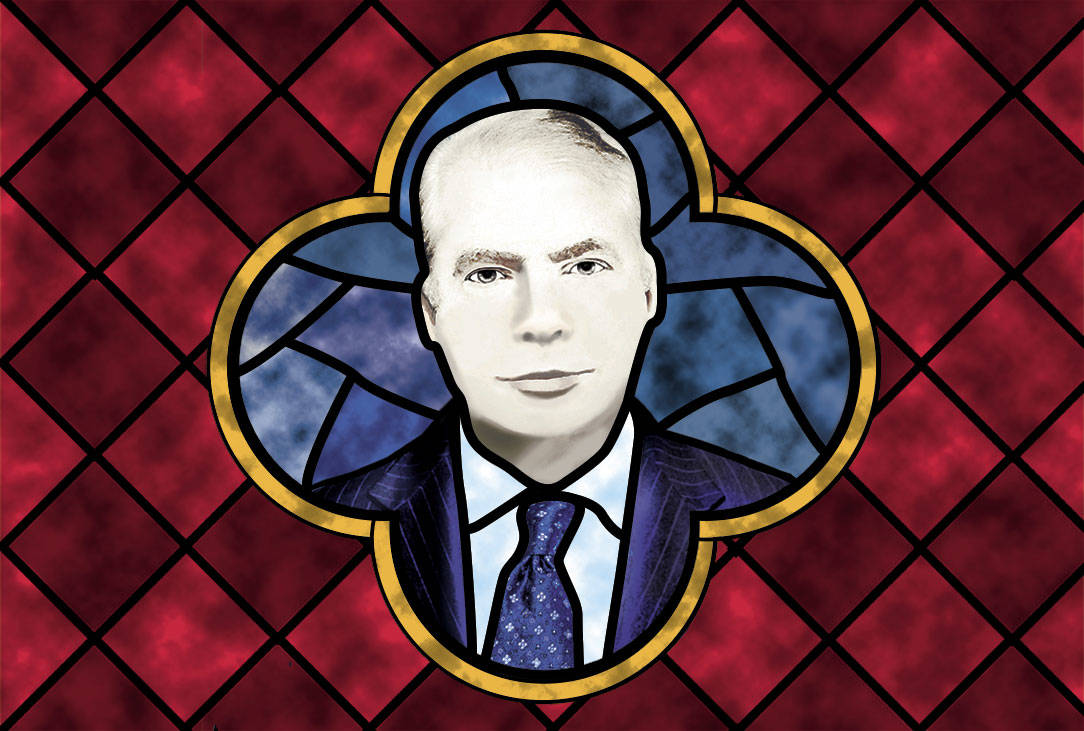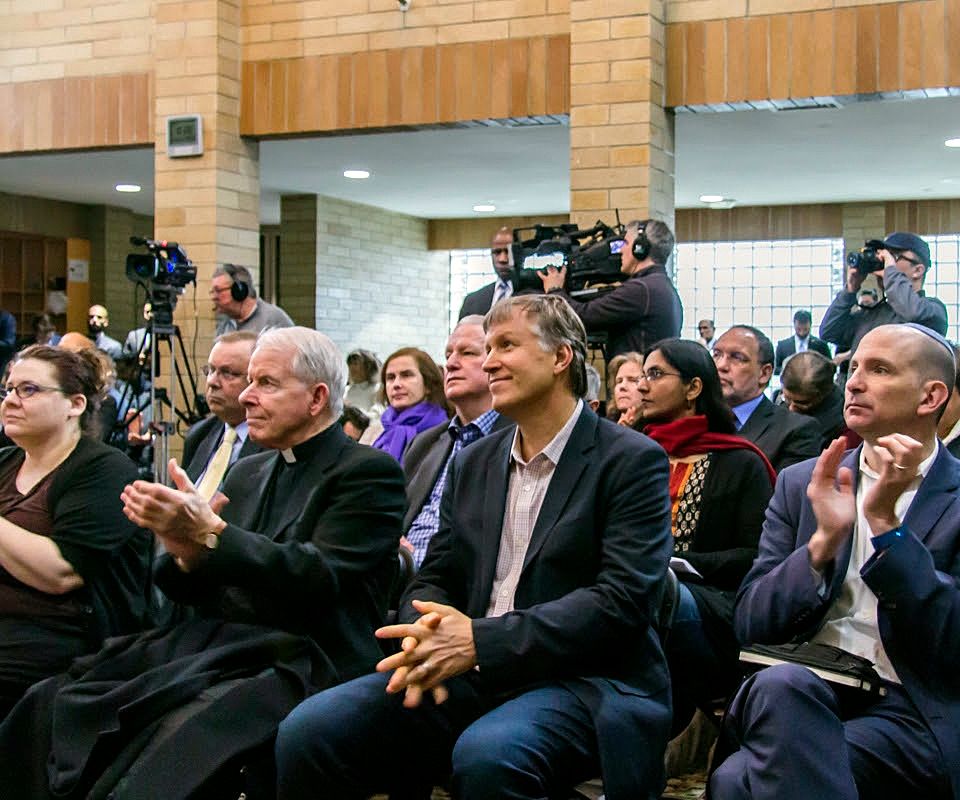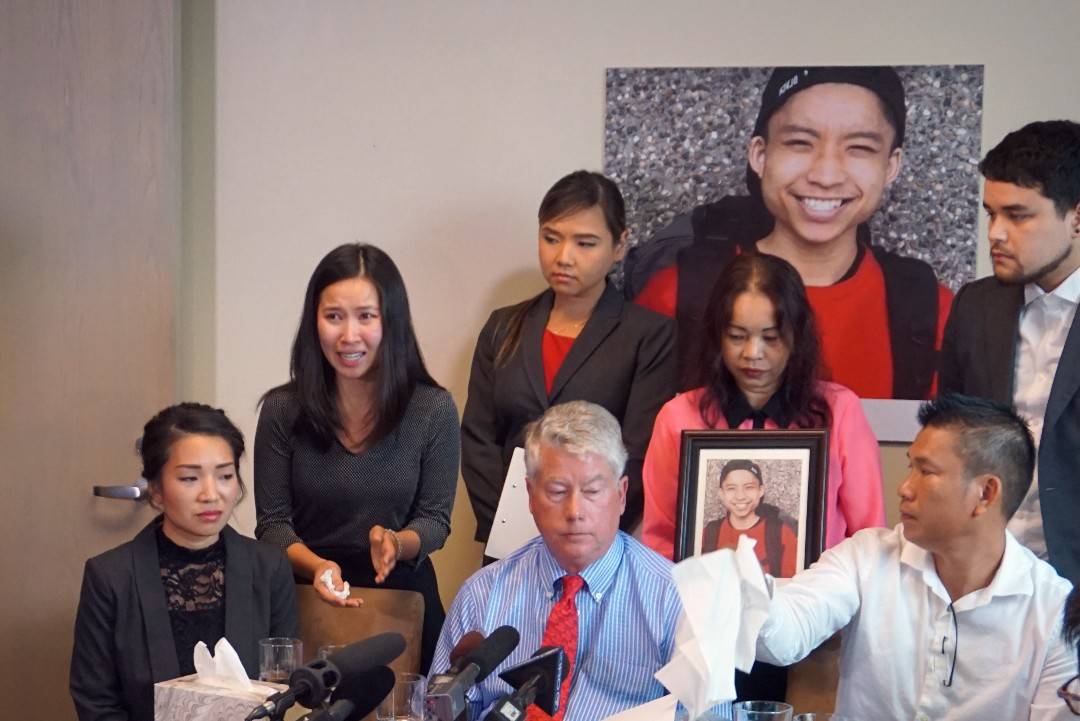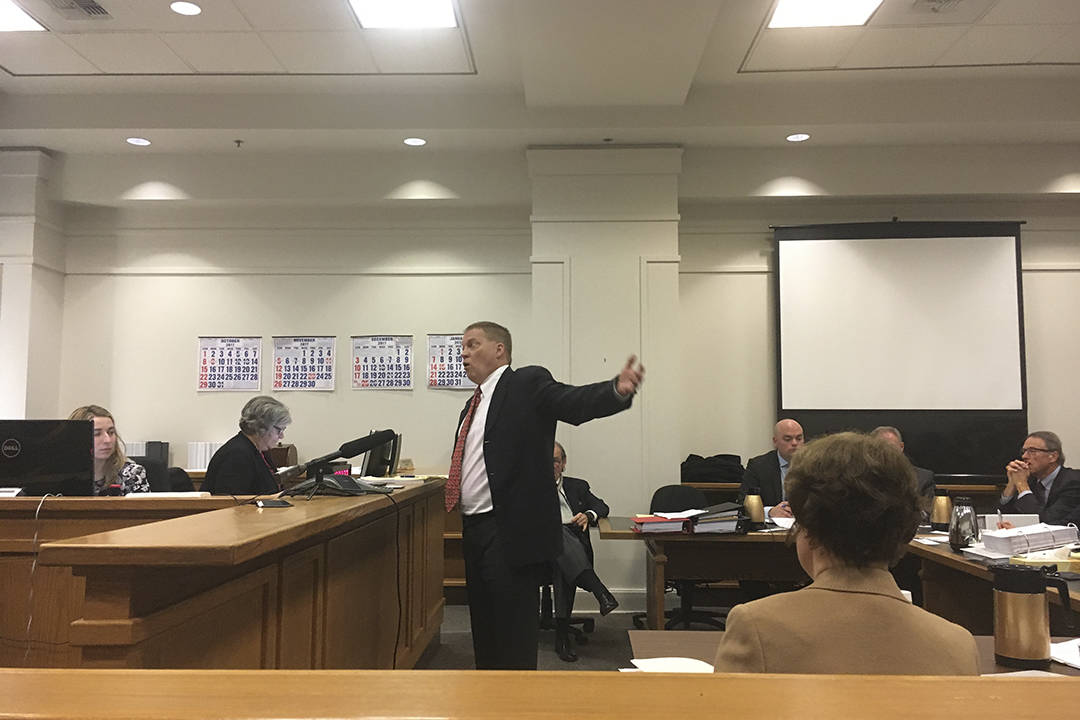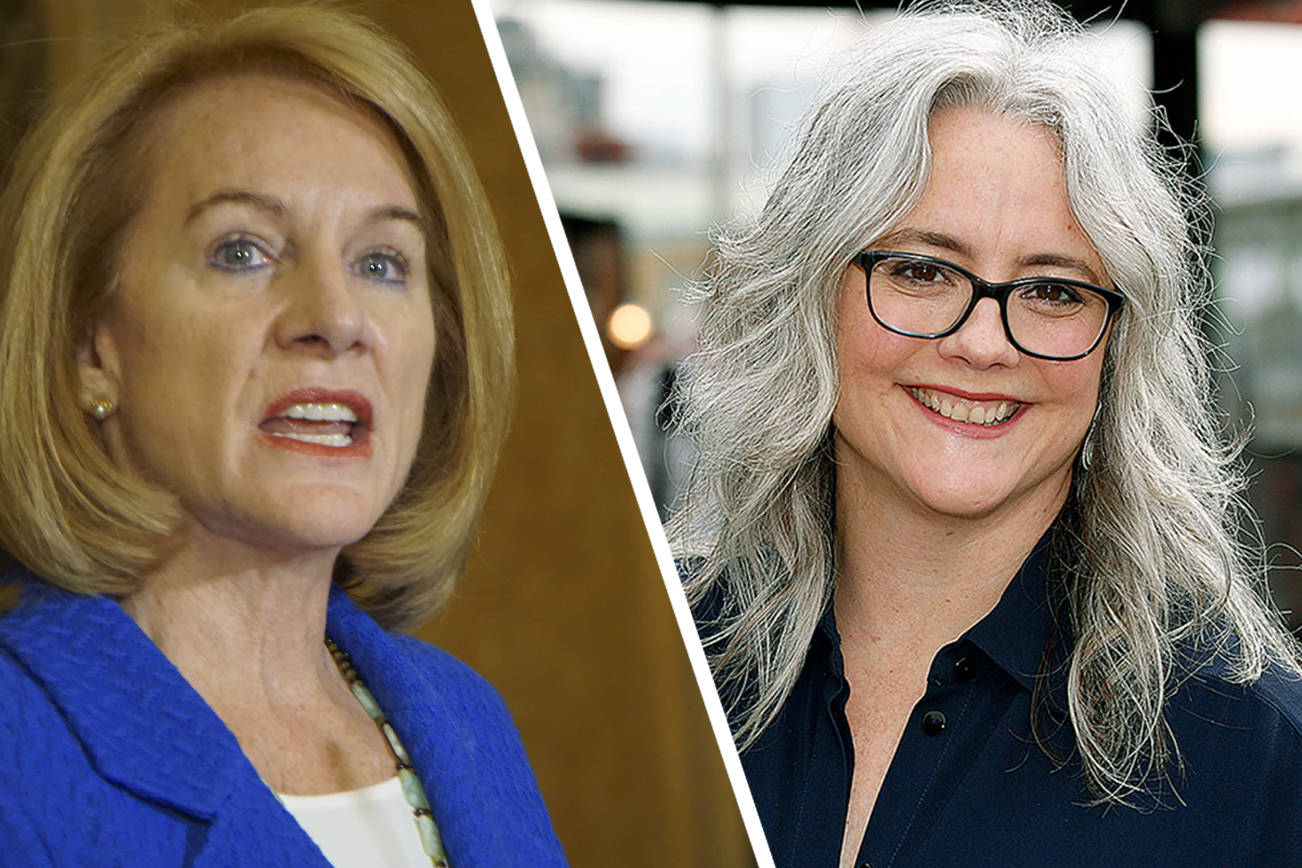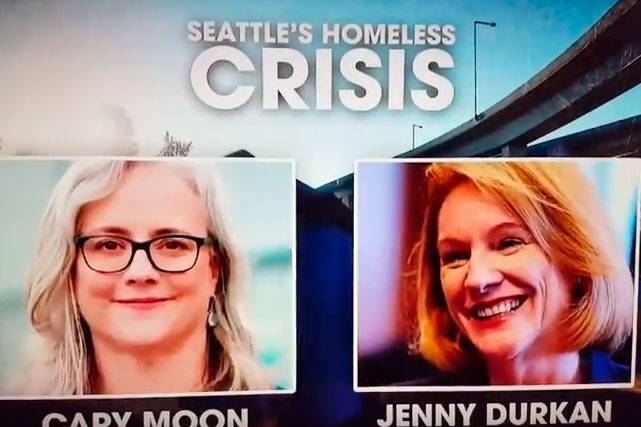At the end of his State of the City address at Idris Mosque in Northgate last week, when it came time to thank his friends, staff, and husband, Mayor Ed Murray looked toward an elderly man in the front row, wearing a Roman collar.
“I also want to acknowledge someone I met as a kid who introduced me to the concept of social justice and the need to reach out to others, particularly those who are most in need, and that’s Father Mike Ryan,” Murray said. “Father, thank you for being here.”
The remarks were not on the prepared transcript sent out by the mayor’s staff to the media prior to the event. They were, though, entirely in line with a recurrent theme in public remarks made by Murray and those close to him—his Catholic faith and its influence in his day-to-day efforts as the leader of the city. Last year, in a special address on homelessness, the mayor invoked Dorothy Day, radical homeless service provider and co-founder of the Catholic Worker movement, in his appeal to the people of Seattle to do more for the homeless. He wears a bracelet on his right wrist that he received while in a hermitage in California, he recently told Crosscut. It is an homage to the Rosary his grandfather carried in Ireland. His husband, Michael Shiosaki, told The Seattle Times in 2014 that Murray’s intense work schedule as mayor comes from “his Catholic roots of serving others, and caring for the poor and aged.”
The fact that Murray is Catholic is not, in itself, remarkable. His two predecessors, Mike McGinn and Greg Nickels, also identified as such, with Nickels growing up in the Seattle neighborhood nicknamed “Catholic Hill” for its heavy concentration of Catholic families. However, neither McGinn nor Nickels made their Catholic faith central to their public identity, as Murray has done in leading a city that surveys consistently show is one of the most secular in the United States. Thirty-seven percent of residents here identify as religiously “unaffiliated,” according to a 2015 poll by the Public Religion Research Institute, tying it with San Francisco and Portland for the least religious city in the country. While the Catholic Church continues to have a large institutional footprint on Capitol Hill—the “Catholic Hill” area Nickels grew up in—its influence quickly diminishes once one leaves the confines of Seattle University, the Providence hospitals, and St. James Cathedral: Citywide, only 13 percent of Seattleites identify as Catholic, according to the PRRI survey.
Indeed, Murray’s Catholic faith can seem a study in contradiction. Not only is he a practicing Catholic in a secular city, he is a gay man who has remained in a church that has been outright hostile toward homosexuality; he is a public official who seeks to follow the path of Day, who refused financial assistance from the government and declined to pay her taxes for years at a time; he is an impossibly busy man who says he feels closest to his Catholic faith when he is practicing quiet Benedictine meditation, which requires he wake at 5:30 a.m. if he has any hope of doing it at all.
Murray’s faith is also compelling when considered in the context of the Catholic Church’s internal battle between what, in American political terms, can be thought of as “liberal” and “conservative” factions. While Murray cautions against trying to understand the church in such raw political terms, it’s true that he, like Pope Francis and former Seattle archbishops like Raymond Hunthausen, falls closer to the liberal pole than the conservative one. And while Seattle, from the Vatican’s perspective, is almost literally at the end of the world, our city has had at times a front-row seat to this battle—and Murray has been right there to witness it, his Catholicism buffeted by the opposing forces.
With all this in mind, I reached out to Murray to talk about his faith. I was not interested in gauging whether Murray was a “true” Catholic—a question that has been raised elsewhere on account of his sexuality and stances on various public-policy issues. Rather, I wanted to better understand this biographical note that, if mentioned, is usually confined to a sentence or two. In two interviews, Murray obliged, discussing his (brief) consideration of the priesthood, his decision to leave the Catholic Church, and, ultimately, his return to the fold and how it has helped guide his first term as mayor.
For American Catholics of Murray’s generation, the 1960s saw two momentous occasions: the election of John F. Kennedy as president and the convening of the Vatican II Council.
Like Kennedy, Murray comes from Irish Catholic stock. His forebears emigrated from Ireland to Elma, Washington, and helped build the Catholic church in that small Grays Harbor County hamlet. Growing up in West Seattle, Murray attended Holy Rosary Catholic School just off California Avenue Southwest, surrounded by Irish nuns. He was only 5 when Kennedy was elected president—the first time a Catholic had won the White House—but steeped in Irish Catholic culture as he was, he could still recognize the energy around him, even if he didn’t fully understand its implication.
“The thing I do remember and that I became more conscious of as I grew up, was the excitement that was going on in my family,” he says of the 1960 campaign. “John Kennedy’s election really was about my parents, my aunts and uncles, my grandparents, viewing that election as fully being accepted as Americans. The question at that time, as I’ve learned looking back, was could a Catholic—and in particular with the prejudice against Irish Catholics—could that person become president?”
Kennedy showed he could, but also provided a model for Catholic politicians on how to do it, lessons that Murray and countless others have taken to heart. In addition to the outright anti-immigrant prejudice that many Americans still felt toward the Irish at the time, Kennedy also had to contend with the idea that, as a Catholic, he would ultimately be beholden to the Pope, since the church’s strict hierarchy requires papal fealty. To assuage those fears, Kennedy gave his famous speech to skeptical Southern Democrats vowing to lead as a servant of the American people, not as an agent for the Vatican. “I believe in an America where the separation of church and state is absolute; where no Catholic prelate would tell the President—should he be Catholic—how to act,” Kennedy said. It was a vow, in other words, that Catholic politicians could separate their public lives from their spiritual ones. As the Catholic journalist Philip F. Lawler wrote decades later about the continuing influence of Kennedy’s speech, “A rising generation of Irish-Catholic politicians conspicuously modeled themselves after President Kennedy, and his devout secularism was an integral part of the style that they cultivated.”
Then, just two years after Kennedy’s election, came the Second Vatican Council. Thousands of bishops convened in Rome from 1962 to 1965 to form policy aimed at modernizing the millennia-old institution. While volumes and volumes have been written debating the Council’s legacy, many liberal Catholics saw Vatican II as a much-needed update. Not only did it end the requirement that Mass be said in Latin, with the priest facing away from the congregation, it also made the church a more open community, and one more explicitly focused on social justice. Not coincidentally, in the years after Vatican II, the Seattle Archdiocese—which sent several clergymen to the Council—became a leading voice in the area on issues like racial desegregation, nuclear nonproliferation, and even non-discrimination toward gay people. The church’s newly found moral authority was an inspiration to a young Ed Murray.
“I grew up in an archdiocese that had this series of fairly progressive bishops,” Murray says. “Archbishop [Thomas] Connolly actually opposed the mayor when the mayor was opposed to integrating public housing. And Archbishop Hunthausen, of course, in his opposition to the military-industrial complex… . So I grew up around nuns and priests, some of whom I still know to this day, who were fairly socially progressive.”
Father Ryan, the priest Murray introduced at the State of the City address, says that by the time he met the teenage Murray in the 1970s, the future mayor was already thinking seriously about the church and its social-justice mission. “He made an impression, which is unusual,” says Ryan, who at that time was involved in youth outreach and meeting a large number of young people. “Normally you meet high-school kids, they’re not thinking about the big picture. Then here’s someone who cared about issues of justice, peace, world issues, that was not typical of his contemporaries. He took a Catholic point of view [on those issues], the Catholic social teaching, which is some ways is one of the best-kept Catholic secrets.”
Father Michael Ryan, left, seen here at the State of the City address, was an early influence on Murray. Photo courtesy of Office of the Mayor
After graduating from high school, Murray attended St. Thomas Seminary in Kenmore, exploring the priesthood. After a year there, he decided against it, and finished his college studies at the University of Portland, a Catholic institution. There he got to know Trappist monks who introduced him to monastic worship, and counseled him on, among other things, his homosexuality, which he began to acknowledge in college. Far from the pious recriminations one might expect, Murray says that in college he was encouraged by priests to embrace that part of himself, rather that feel shame about it. It was further evidence, for Murray, that the Catholic Church, especially in its social-justice form, was a home for him, rather than the prison many people considered it.
“When I was in college and trying to come to terms as a gay person, the teachings of the Church were pretty negative. At the same time, there were people in the Church who actually helped me come out,” he says. “There was a Trappist monk who recommended some books on the Church and homosexuality, and really encouraged me to … live as a healthy out person—versus the theological term ‘disordered’—but you have to remember this was before Pope John Paul II.”
John Paul II, pope from 1978 until his 2005 death and still beloved across much of the Catholic world, was seen by many progressives as an enemy of the advancements made through, and following, Vatican II. His conservative efforts were felt acutely in Seattle, as the Vatican engaged in a pitched battle with Archbishop Hunthausen over his management of the archdiocese. Hunthausen, who as a young bishop attended Vatican II, was considered an embodiment of the reformist efforts. In addition to using the pulpit to denounce America’s nuclear-weapon stockpile in the Puget Sound area—pronouncements that, according to Seattle journalist and former Seattle Archdiocese spokesman John McCoy, reached, and angered, the Reagan administration—Hunthausen also ran afoul of the Vatican when he began to allow the gay Catholic group Dignity to meet at St. James Cathedral.
In the mid-1980s, John Paul II sent none other than Cardinal Joseph Ratzinger—later, Pope Benedict XVI—to Seattle to investigate Hunthausen. McCoy, who in 2015 published A Still and Quiet Conscience: The Archbishop Who Challenged a Pope, a President, and a Church, a book about the Archbishop and his battles with the Vatican, writes of a telling exchange between Hunthausen and Ratzinger that speaks to the bitter conflict in the Church over how it should conduct itself, especially on questions around the culture wars that were sweeping the country. According to McCoy, Ratzinger confronted Hunthausen about allowing Dignity to meet at the church. Hunthausen defended himself by saying, “I tried to do what I thought Jesus would do.” Ratzinger, McCoy reports, was “infuriated.”
While Hunthausen was not removed from office by Ratzinger, he did retire early, in 1990 at age 70. This brought an end to the archdiocese’s string of liberal leadership and ushered in a period of more traditional archbishops who put a heavier emphasis on issues like sex (it should remain confined to marriages between men and women) and abortion (it should be outlawed). For Murray, the period would bring his relationship with the Catholic Church to a breaking point.
By that time, Murray was heavily involved in local Democratic politics. In 1988 he managed Cal Anderson’s successful campaign to become the first openly gay legislator in Washington. When Anderson died of AIDS-related complications in 1995, a state House member was appointed to fill his Senate seat, and Murray was appointed to fill the vacated House seat—thus becoming the state’s second openly gay lawmaker. Around that time, the Seattle Archdiocese, now under the leadership of Archbishop Thomas Murphy, reversed its long-held position on a state bill that extended anti-discrimination protections to LGBT people. Introduced in 1977, the measure was supported by the Church under Hunthausen. A few years after Hunthausen’s retirement, the archdiocese announced it would oppose it. Murray was devastated. After sticking with the Church for years, despite its poor record on many gay-rights issues, Murray says he couldn’t take it any more.
“Most of my friends would die by the time I was 40 of AIDS, [and] we had a pope [John Paul II] who was pretty horrible on the issue of HIV/AIDS,” Murray says. When the archdiocese reversed its stance on the anti-discrimination bill, “you had a Church that was opposing my civil rights.
“I reached a point where it’s like, this does not work. This does not work for me.” At 40 years old, he quit practicing Catholicism.
In this, Murray joined legions of other white liberals who have left the flock in recent generations. When Kennedy was elected, the phrase “Catholic Republican” was almost an oxymoron, as the Republican Party of the late 1800s and early 1900s found common cause with anti-immigration groups that sought to limit the number of Catholics from Ireland and Italy allowed into the country. But no longer. In the five most recent presidential elections, the Republican presidential candidate, more likely to align with Catholic stances on issues like abortion and gay marriage, has won the white Catholic vote, according to the Pew Research Center. This includes 2004, in which the Catholic John Kerry faced off against the born-again George W. Bush. In 2016, Donald Trump, who engaged in a war of words with Pope Francis during the campaign, won the white Catholic vote by a margin of 23 points, according to Pew. When Hispanics are considered, the Catholic vote is more evenly divided between Republicans and Democrats; but the fact is that for many Irish Catholic Democrats like Murray, it’s become a choice: Catholic or Democrat. Murray notes that when he was in the legislature, a majority of his Democratic colleagues were raised Catholic; few, however, were practicing. Kennedy’s “devout secularism,” as journalist Lawler called it, had become simple secularism.
But for Murray, life outside the church proved less tenable that his life within it. Strangely, what brought Murray back to the church was the work of a Protestant, Kathleen Norris. In 1997, during Murray’s second full term in office, the South Dakota author published The Cloister Walk, a memoir of her time spent at Benedictine monasteries. A bestseller, it reminded Murray of his time with the Trappist monks in Oregon. “I read it, and it really was like a glass wall shattered. Here was a Protestant woman from the Dakotas introducing my tradition back to me. … I didn’t feel spiritually whole until I came back to the church as a practicing Catholic. There’s no other explanation I can give for it: As a spiritual home and a spiritual experience, it’s where I belong.”
Having recommitted to the Catholic faith, Murray has in the intervening years maintained an uneasy balance between his spiritual life and his public one. In the 2000s, conservative forces in the church became more aggressive toward those they considered on the wrong side of public policy. During Kerry’s 2004 presidential campaign, some archbishops forbade Kerry from taking Communion at their churches for his pro-choice stance on abortion—an unprecedented move by the Catholic hierarchy and an indignity never visited upon politicians who, for example, voted to cut welfare for the poor in order to ease taxes on the rich.
In 2012, by which time Archbishop Hunthausen’s old foe Ratzinger had been elevated to the papacy, Murray worried that the Seattle Archdiocese would do the same in retribution for the state’s marriage-equality law—of which Murray was the primary sponsor and, as majority leader in the Senate, ushered through to passage. With the archdiocese actively campaigning against the law, it was not farfetched for Murray to fear a backlash. “I remember having a conversation [with another Catholic elected official] about the anxiety and pain that that kind of action would create for us,” Murray says. “To be denied [the Sacraments] is to be separated from the heart of your spiritual tradition.”
Murray was not denied Communion after all, but the archdiocese did ask its parishes to help collect signatures to put Referendum 74, which would have repealed the marriage-equality law, on the ballot. Many Seattle pastors, including Ryan at St. James Cathedral, refused, saying it would be too divisive for their parishes.
The effort to repeal the law failed, and in 2013 Murray and his partner Michael Shiosaki availed themselves of their new right to wed. They did so at Shiosaki’s Episcopal parish, with many of Murray’s Catholic friends not in attendance. “One of my friends who was a priest, who has since died, texted me and said, ‘I would love to come to your wedding, but I want to stay a priest.’ None of the people who I knew through my whole life who were still in the Catholic clergy could come to St. Mark’s Episcopal Cathedral and see me and be part of my wedding.”
Some Catholic friends of Murray’s did not attend his wedding, for fear of retribution from the church. Photo courtesy of Office of the Mayor
Murray says many of his friends cannot understand why he puts up with it all. “They just don’t get it. They go, ‘Look at the Church’s position on women. Look at the Church’s position on gays and lesbians.’ And I see that. I experience that,” he says. But Murray, who has a reputation for being combative in the realm of politics, revels in the conflict, in the debate. “If you read the Gospel, it is not about being together with a bunch of people you feel good about. It’s about being places that are uncomfortable with you. So am I challenging myself more as a Christian if I sit in a congregation where everyone believes the same as I do, or am I being more of a Christian if I’m sitting in the congregation where the nun in the pew ahead of me goes down and testifies against marriage equality and sometimes I want to throw a missal at her head?”
That said, Murray now and then has sounded as if he is ready to give up. At the time of his nuptials, he was running for mayor, and interviews suggested a strained relationship with the Church. When Publicola asked him about his Catholic faith, he said he still attended Mass “most Sundays,” but added: “I’ve actually been kind of waiting for the other shoe to drop … I always have one foot in the door and one foot out the door. I never know if I’m going to stay or if I’m out.”
Today, the mayor seems more surefooted when talking about his Catholic faith—in part no doubt because his public-policy focus has shifted from same-sex marriage to poverty. For someone raised on the writings of Day and now leading a city that counts at least 3,000 homeless people among its population, the connection between faith and civic responsibility is easy to make. Still, the mayor’s faith does conflict with his approaches to the issue. As a politician who must compromise to lead, Murray is not able to fully live by Day’s model; by invoking her, as he has on numerous occasions, he is setting a bar he can’t possibly meet. An editorial published by this paper in August criticizing his administration’s plan to clear a homeless encampment in West Seattle (“Stop Evicting the Homeless,” Aug. 3) posed the question “Why is Murray—an avowed social-justice Catholic given to quoting Dorothy Day—chasing homeless people out of their tents and shacks?”
Murray defends his record on homelessness, noting that he’s drastically increased funding for homeless services. (During his State of the City speech, he announced an effort to pass a $55 million levy dedicated to funding for the homeless.) However, he recognizes the limitations he faces. “On some days, I’ll read things like Matthew, Chapter 25: Did you feed me when I was hungry? Did you clothe me? Did you welcome me when I was a stranger? That’s exactly who the homeless are. But how do I live that out in a city that’s also seen a rise in garbage and destruction and criminal activity?
“When it comes to the issue of homelessness, part of me wants to go and just move into an encampment … you know, as Francis of Assisi or Mother Teresa or Dorothy Day. Live with those that are being rejected. The other part of me, as mayor of a city, I see people in encampments who are not the desperate—most of them are desperate—but we have some pretty bad players out there too. There’s a tension there between my needing to find a way to assist those who are most in need and my need to also enforce the law on those who are causing a significant amount of disorder.”
Like many liberal Catholics, Murray, after years of living in sharp disagreement with Church leadership, has found inspiration in the form of Pope Francis. Elected after Pope Benedict XVI stepped down in 2013, he has proven a breath of fresh air for Catholics who long to see the Church return to its mid-20th century social-justice mission and away from its laser focus on sex. Mark Shriver, John F. Kennedy’s nephew, wrote in his recent biography Pilgrimage: My Search for the Real Pope Francis, that at the time of Francis’ election he had become “uncertain whether the Church remained a force for good in the world.” While at first finding Francis’ message too good to be true, he was quickly inspired. “Francis was single-handedly answering my needs and wants, and I started to make his thoughts and reflections a part of my daily prayers and reflections. I started to emerge from my Catholic funk,” Shriver wrote.
Murray says he was skeptical of Francis at first as well. But he was soon convinced that Francis was true to his hype—a fact underscored in 2015 when Francis released his encyclical on climate change as a social-justice issue. Shortly after publishing the teaching, Pope Francis invited 40 mayors from across the world to the Vatican to discuss ways to fight climate change. Among them was Murray, the man who had considered the priesthood, left the Church in a rage, and more recently been made to feel like such a pariah that he feared being denied Communion.
Murray says he was unsure at first whether the Vatican had made a mistake. “When they sent the invitation, we had folks call the Vatican and say, ‘Are you sure you understand who I am, and that you’re inviting me?’ ” Murray says. “They said, yes, they wanted me to come.”
dperson@seattleweekly.com
Read more about Raymond Hunthausen in Seattle Weekly’s 1983 profile on the archbishop, written by Cynthia H. Wilson, here.
